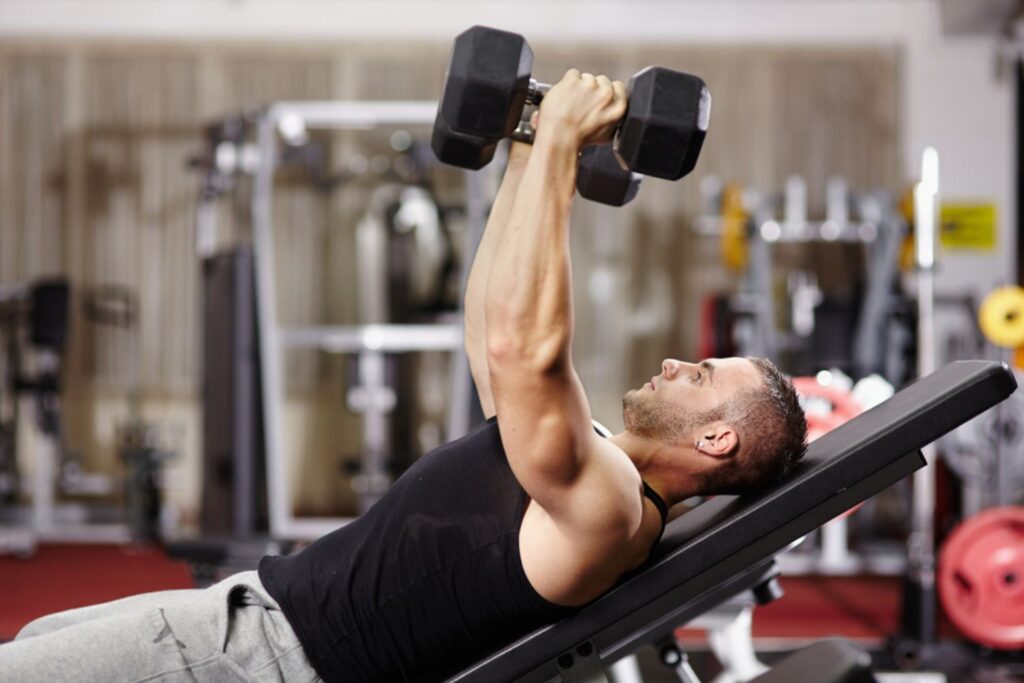BUILDING ARM MUSCLE is about more than just one move. Yes, the dumbbell biceps curl is one of our favourites and worthy of your time and energy, but when you’re ready to progress beyond the basics, there are other exercises – and other muscles in your arms – that should demand your attention. To round out your arms, you’ll need to train your brachialis muscles. To train your brachialis muscles, you’ll need the dumbbell hammer curl.
The dumbbell hammer curl might not look radically different than the standard variation of the movement – in the simplest way to describe both, you hold a dumbbell, raise it up to your shoulder, then lower it back down and repeat – but there are some very important nuances between the two exercises. Let Men’s Health fitness director Ebenezer Samuel, C.S.C.S. and Brett Williams, NASM guide you through the move’s subtleties, saving you from the bad habits that are keeping you from unlocking your fitness potential.
Benefits of the dumbbell hammer curl
The biggest shift from the standard biceps curl and the hammer curl is in the grip. When you perform a standard curl, you’ll use an underhand (or supinated) grip as you raise the weight up. Your biceps will be the main muscle driving that movement. For the hammer curl, you’ll adjust your position and use a neutral grip. This shifts the focus to the brachialis, another muscle that sits beneath the biceps and is the primary mover for elbow flexion. By making this shift, you’ll get stronger – and your biceps will pop from any brachialis growth, too.
“When we develop our brachialis, it’s going to really help push our biceps up and give us a nice 3D look,” Samuel says.
There’s another big reason to do the hammer curl in addition to the standard biceps curl: You’ll be able to train with heavier loads. Standard curls also train biceps supination (rotating the forearm outward), another function of the muscle. Since you’re not including that rotation with the hammer curl, you’ll have an easier time working with more weight. And as Samuel says: “Bigger weight equals bigger muscles.”

How to do the dumbbell hammer curl
- Stand with your feet hip-width apart, holding a pair of dumbbells in a neutral grip (palms facing each other). Squeeze your shoulder blades, abs, and glutes to create full-body tension.
- Curl the dumbbell up, moving only at the elbow joint. Keep your upper arms still and perpendicular to the floor. Squeeze your biceps at the top of the movement.
- Avoid shifting your elbow forward to keep your shoulders out of the movement.
- Lower the weight back down to the starting position under control.
Use this extra insight from Samuel for even more effective reps.
Tighten your whole body
Eb says: This is a curl, but that doesn’t mean your body gets to be in anything close to a lazy position. In order to get the most out of this (or any) curl, you need to make sure you’re moving only at the elbow joint. To insure that, we need to tighten any point where we might cheat. So tighten your glutes and abs, then squeeze your shoulder blades tight, too. That’ll help you erase most of your possible swinging points.
Grip the dumbbells like you mean It
Eb says: Don’t just hold the dumbbells during this curl; actively grip them. Think about really tightening your hands around each dumbbell, holding it tightly. This will grant you more control over the dumbbell, and it’ll also help insure that your brachialis drives the motion. Added bonus: You’ll strengthen your forearms and gripping muscles, too.
Squeeze at The top
Eb says: Curl the dumbbell only as high as it’ll go without forcing you to shift your elbow forward, but once you get there, the curl isn’t done. Once you’re in that position, do your best to squeeze your biceps and arm in general. This little act will force a half-second or so of extra time-under-tension at the top, and it’s going to help you develop a stronger mind-muscle connection. It’ll also help prevent you from swinging.
When in doubt, kneel
Eb says: The most common cheat on any curl is the waist-rocking cheat, where you create motion at your hips to initiate the curling motion. The easy fix to that: Get on your knees.
The position will make you that much more conscious of squeezing your glutes and tightening your abs, which instantly limits your ability to create that waist rock, or other cheats (like arching your back, etc.)
How to add the dumbbell hammer curl to your workout
Add the hammer curl to your upper body or arm day workouts so you can give your brachialis muscles some focused work. Start with 3 sets of 6 to 8 reps with heavier weights than you’d use for a standard curl. For extra volume, use lighter weights but more reps – say 3 to 4 sets of 15 to 20 reps.
This piece was originally seen on Men’s Health U.S.
Related articles:
















